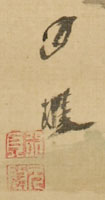Shijô
Rantei - Purifacation at the Orchid pavillionSigned: Gesshô
Seals: Yukisada (Gyôtei) Genkei
Technique: colours on silk 86.8 x 32.6
Mounting: blue and brown gold damask 187 x 47.7
Condition: fine
Rantei, gathering of poets at the Orchid pavilion is a theme popular amongst bunjin. It is derived from a painting from 1671 by Fan I, an early Ch'ing dynasty painter from Nanking, which was already in Japan in 1707 (and which was eventually acquired by Tomioka Tessai (1836-1924)).
- The scene is representative of the famed 'Lanting gathering' at the Orchid Pavillion at the foot of Mt. Huiji in Zhejiang province, China. In the spring of the year 353 the renowned calligrapher Wang Xizhi invited 41prominent men to a poetry party. Sitting along the shores of a slowly winding stream, the guests were asked to compose a poem before cups of wine, which had been floated on the stream, were within their reach. The penalty for non-completion of a poem was to drink the wine. The participants managed to create 37 poems on the day. (Zeno)
- Wang Hsi-chih (321-379) (Wang Xizhi) is considered one of the most influential calligraphers from China. He is usually depicted in the company of a white goose, because the movement of his brush was compared to the way a goose moves through water. Absent in this painting, but another variant, is that his white goose eventually turned black, as a result of his brushes being cleaned in the water.
In the year 353 Wang invited forty-two scholar poets to celebrate the Spring Purification Festival at the Orchid pavilion. We see the guests engaged in a poetry and drinking contest along the bank of a stream. Servants set out wine-filled cups on lotus leaves to float down the stream. Whenever one of the wine cups hit the bank the guest was required to compose a poem and empty the cup. (Tinios)
Gesshô was born in Hikone, Ômi Province as the son of a scroll mounter.
Before Gesshô moved to Nagoya he studied in Kyoto with the Nanga painter Ichikawa Unkei (1736-1803) and later with Go Shun (1752-1811) and Tanke Gessen (1721-1809). When after a number of visits in 1798 he finally went to Nagoya to settle there, Rosetsu (1754-1799) came with him. Once in Nagoya he became a leading artist with Yokoi Kinkoku (1761-1832) and Yamamoto Baiitsu (1783-1856) among his pupils. As a poet and a haiga painter he was involved in several haiga and kyôka anthologies.
Bunchô appreciated Gesshô's work and suggested that he move to Edo, but Gesshô, who was quite comfortable in Nagoya, decided to stay.
Reference:
Roberts p. 32
Araki p. 327
Hillier pp. 170-181
Fister '83 pp. 33, 34, 38
Price: ON REQUEST

